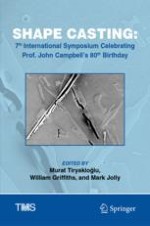2019 | Buch
Shape Casting
7th International Symposium Celebrating Prof. John Campbell's 80th Birthday
herausgegeben von: Dr. Murat Tiryakioğlu, Dr. William Griffiths, Dr. Mark Jolly
Verlag: Springer International Publishing
Buchreihe : The Minerals, Metals & Materials Series
